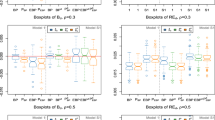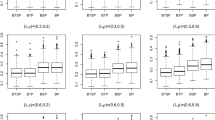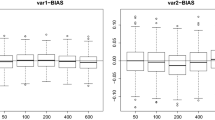Abstract
The paper studies the applicability of area-level Poisson mixed models to estimate small area counting indicators. Among the available procedures for fitting generalized linear models, the method of moments (MM) and the penalised quasi-likelihood (PQL) method are employed. The empirical best predictor (EBP) of the area mean is derived using MM and compared with plug-in alternatives using MM and PQL. The plug-in estimator using PQL is computationally faster and provides competitive performance with respect to EBP that involves high complex integrals. An approximation to the mean squared error (MSE) of the EBP is given and three MSE estimators are proposed. The first two MSE estimators are plug-in estimators without and with bias correction to the second order and the third one is based on parametric bootstrap. Several simulation experiments are carried out for analysing the behaviour of the EBP and for comparing the estimators of the MSE of the EBP. A good choice in practice is the bootstrap alternative since it performs similarly to the analytical versions and is computationally faster. The developed methodology and software are applied to data from the 2008 Spanish living condition survey. The target of the application is the estimation of poverty rates at province level.





Similar content being viewed by others
References
Breslow NE, Clayton DG (1993) Approximate inference in generalized linear mixed models. J Am Stat Assoc 88:9–25
Datta GS, Lahiri P (2000) A unified measure of uncertainty of estimated best linear unbiased predictors in small area estimation problems. Stat Sinica 10:613–627
Esteban MD, Morales D, Pérez A, Santamaría L (2012) Small area estimation of poverty proportions under area-level time models. Comput Stat Data Anal 56:2840–2855
Fay RE, Herriot RA (1979) Estimation of income from small places: an application of James–Stein procedures to census data. J Am Stat Assoc 74:269–277
Ghosh M, Rao JNK (1994) Small area estimation: an appraisal (with discussion). Stat Sci 9:55–93
González-Manteiga W, Lombardía MJ, Molina I, Morales D, Santamaría L (2007) Estimation of the mean squared error of predictors of small area linear parameters under a logistic mixed model. Comput Stat Data Anal 51:2720–2733
González-Manteiga W, Lombardía MJ, Molina I, Morales D, Santamaría L (2008b) Bootstrap mean squared error of small-area EBLUP. J Stat Comput Simul 78:443–462
González-Manteiga W, Lombardía MJ, Molina I, Morales D, Santamaría L (2008a) Analytic and bootstrap approximations of prediction errors under a multivariate Fay–Herriot model. Comput Stat Data Anal 52:5242–5252
Jiang J (1998) Consistent estimators in generalized linear models. J Am Stat Assoc 93:720–729
Jiang J (2003) Empirical best prediction for small-area inference based on generalized linear mixed models. J Stat Plan Inference 111:117–127
Jiang J, Lahiri P (2001) Empirical best prediction for small area inference with binary data. A Inst Stat Math 53:217–243
Jiang J, Lahiri P (2006) Mixed model prediction and small area estimation. Test 15:1–96
Johnson FA, Chandra H, Brown J, Padmadas S (2010) Estimating district-level births attended by skilled attendants in Ghana using demographic health survey and census data: An application of small area estimation technique. J Off Stat 26(2):341–359
Lahiri SN, Maiti T, Katzoff M, Parsons V (2007) Resampling-based empirical prediction: an application to small area estimation. Biometrika 94:469–485
Lin X (2007) Estimation using penalized quasilikelihood and quasi-pseudolikelihood in poisson mixed models. Lifetime Data Anal 13:533–544
López-Vizcaíno E, Lombardía MJ, Morales D (2013) Multinomial-based small area estimation of labour force indicators. Stat Model 13:153–178
López-Vizcaíno E, Lombardía MJ, Morales D (2015) Small area estimation of labour force indicators under a multinomial model with correlated time and area effects. J R Stat Soc Ser A 178:535–565
MacNab YC, Lin X (2009) On empirical bayes penalized quasi-likelihood inference in GLMMs and in Bayesian disease mapping and ecological modelling. Comput Stat Data Anal 53:2950–2967
Pfeffermann D (2002) Small area estimation—new developments and directions. Int Stat Rev 70:125–143
Pfeffermann D (2013) New important developments in small area estimation. Stat Sci 28:40–68
Prasad NGN, Rao JNK (1990) The estimation of the mean squared error of small-area estimators. J Am Stat Assoc 85:163–171
Rao JNK (1999) Some recent advances in model-based small area estimation. Surv Methodol 25:175–186
Rao JNK (2003) Small area estimation. Wiley, New York
Rao JNK (2008) Some methods for small area estimation. Riv Intern Sci Soc 4:387–406
Saei A, Chambers R (2003) Small area estimation under linear and generalized linear mixed models with time and area effects. In: Methodology working paper no M03/15 Southampton Statistical Sciences Research Institute, University of Southampton, UK
Särndal C, Swensson B, Wretman J (1992) Model assisted survey sampling. Springer, Berlin
Acknowledgments
The work was supported by the grants MTM2013-41383-P, MTM2014-52876-R, MTM2011-22392, MTM2008-03010 and MTM2012-37077-C02-01 of the Spanish “Ministerio de Ciencia e Innovación” and by “Xunta de Galicia” CN2012/130.
Author information
Authors and Affiliations
Corresponding author
Electronic supplementary material
Below is the link to the electronic supplementary material.
Rights and permissions
About this article
Cite this article
Boubeta, M., Lombardía, M.J. & Morales, D. Empirical best prediction under area-level Poisson mixed models. TEST 25, 548–569 (2016). https://doi.org/10.1007/s11749-015-0469-8
Received:
Accepted:
Published:
Issue Date:
DOI: https://doi.org/10.1007/s11749-015-0469-8




